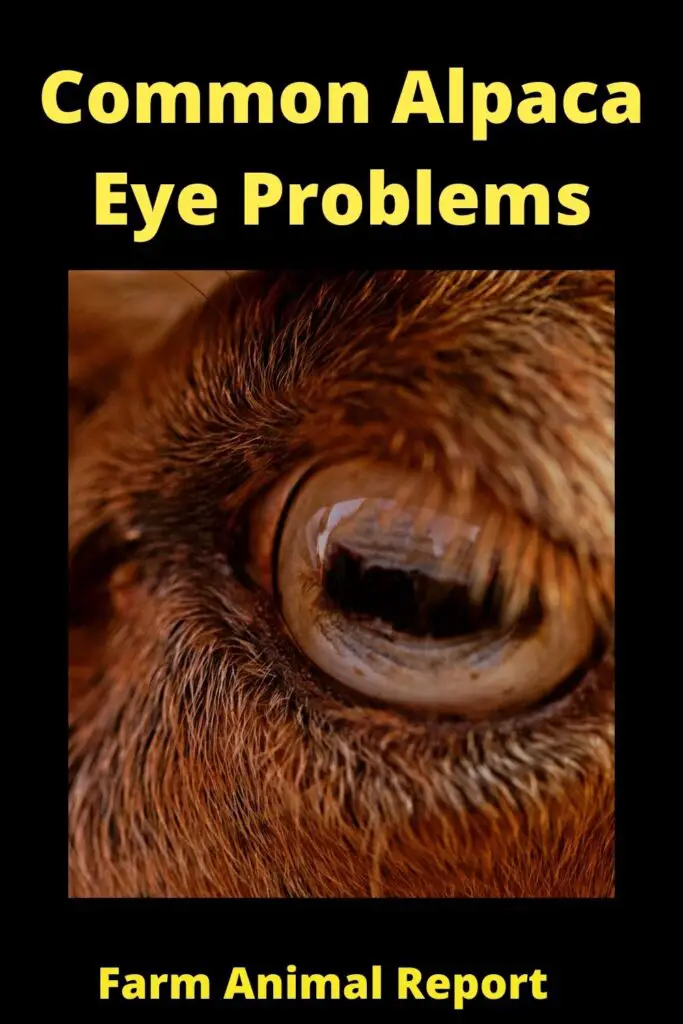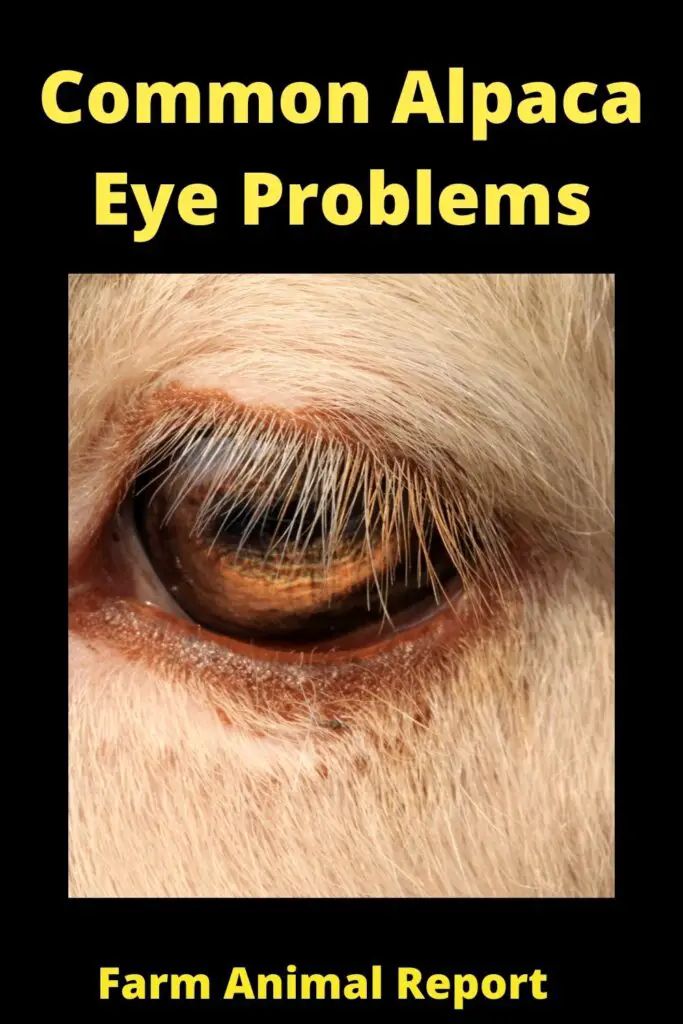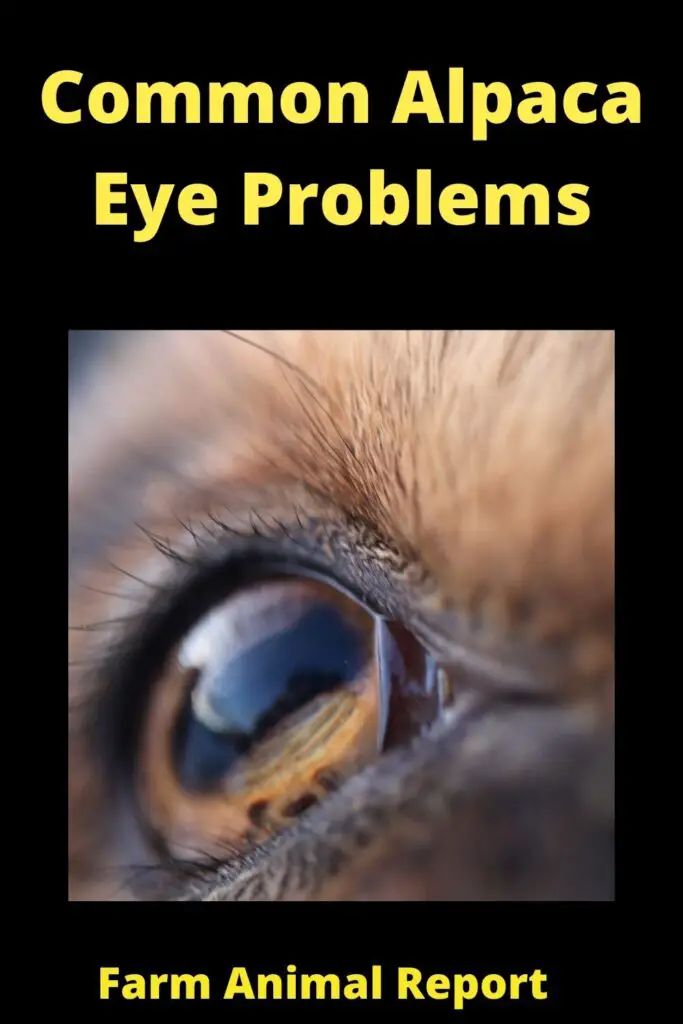As a General Rule Common Alpaca Eye Problems include Anemia, Pink Eye, Munge, and Corneal Ulcers. Symptoms include Blurred Vision, Eye Discomfort, Dry Eye, Eye Nites, Eye Discharge, Red Eyes, and Swollen Eyes.
Alpaca Eyes Problems
Alpaca is a species of South America that belongs to the Camelidae family. Alpacas are intelligent, and hardy animals like other Camelidae members. Some people confuse it with llamas. There is a lot of difference between them. Alpacas are smaller in size, slender bodies, with long necks and legs. They are lining in a group. The two breeds that are mostly found in South America, and all over the World, that are the Suri Alpaca, and the Huacaya Alpaca.
Check Out Amazon’s Educational Resources for Raising Alpacas
Their fiber comes in a variety of colors, more than 52 natural colors that are described in Peru, 12 as classified in Australia, and 16 as classified as in United America. Alpacas communicate through body language. Most common is spitting when they are stressed, fearful, and showing dominance.
Alpacas are primarily important in the textile industry because their mohair is used in the stylish fabric. Males are usually more aggressive than females. Adult alpacas are generally 81-99 centimeters in height. They usually weigh between 48-84 kg. Alpacas live in temperate conditions in the mountains and at high altitudes. Alpacas are native but found all over the World. They feed grass, pasture, and silage. They usually eat 1.5% of their body weight. Alpaca Eyes Problems
Alpacas Eyes
Alpaca Eye Problems – The eye of a healthy alpaca will be clear and bright. Both eyes will usually appear the same except in specific disease conditions like trauma, and other ocular diseases involve one or both eyes. Discharge from the eye is naturally seen as wetness or staining on the cheek underneath the eye is generally an indication of aggravation inside the eye. The eyes are closed, especially when the alpaca is outside. It is an indication of agony in the eyes.
The conjunctiva (layers encompassing the eye) pale pink tone. In case they are blushed, this might be an indication of aggravation. The outer layer of the eye ought to be smooth and straightforward. Any imperfections in the surface or shadiness underneath the eye need brief veterinary counsel. Note that adjustments of the eye can be optional to foundational infections or because of essential eye sickness.

Do Alpacas have Rectangular Pupils?
Since llamas and alpacas originated from the high mountains of South America, they adapted to a climate with few trees and little shade by the use of the granular iridic, otherwise iridic granule. The iridic granula is a part of the eye that shades the pupil and decreases the amount of light that enters the eye and reaches the retina. The pupil is horizontally elliptical, which allows the pupil to close and decrease the amount of light that enters the llama/alpaca eye in sunny, bright conditions. The pupil changes automatically, like the photochromic lenses in someone’s glasses. You can see the iridic granule by looking into the animals’ eyes.
Do Alpacas have Good Eyesight?
Yeah, alpacas have good eyesight. Alpaca find many things in the far distance that human does not see with their own eyes. Such things that alpacas see at a great distance are cats, dogs, and other predators. They remain very alert all the time. When alpaca feel danger, an alarm has sounded, and all young and adult herds arrange into a circle and protect them against the dangerous condition. Then the leader of the alpaca’s group changes the intruder by stomping and kicking. They generally suppress the predator and move a safe distance.
What Color eyes do Alpacas Have?
Alpacas have a wide variety of eye colors like in the human eye. The eye color ranges from brown to light blue. Some people say all blue eye alpaca carry the deafness genes are silly. One interesting thing, people were fighting and paying dollars for them. The reason for pay dollars, that alpaca had the finest fiber.
This is true today scientifically the alpaca who the deafness gene has the finest fur. They are free mixing of other colors. The animal that carries the deafness gene must absent any pigment on the body, ear channel, nose tip, and toe. The alpaca that carries the deafness gene has great demand in the industry.
What Color Eyes do Alpacas Have?
Eye color is also essential in inbreeding. The opposite of alpaca is to ignore them and mate alpacas while disregarding their eye color. A center route is kept away from the mating of blue-eyed alpaca to each other. This widely appealing methodology is probably going to relieve any difficult things that the quality may have, basically because the raiser is keeping away from the mating together of outrageous creatures.
Do Alpacas have Good night Vision?
Alpaca have amazing eyes not dissimilar to other Camelidae members. They are solid brown and light blue eyes and check all the things that ignore you. They have seen in darkness like cats, dogs, and predators and protect them.
Some interesting facts about Alpacas
- Alpacas have only two breeds, the Huacaya, which has fluffy hair like a teddy bear, and the Suri which has long hair that hangs down from their body.
- Like llamas, alpacas also spit when they are angry and annoyed.
- Alpacas have a soft pad on their feet, which does not break up the ground, like other hard pad animals such as cows and horses.
- Alpaca snip the only top of the grass when they are grazing, unlike some other animals. They pull up the grass by the root when they are grazing.
- Females always birth their babies in the morning because the temperature of South America is down at night time. So, they birth their babies in the morning, and the babies will have the whole day to dry off, begin walking around, and nursing from the mother before the temperature down.
- Alpacas have 11 months gestation period. They need no assist to deliver their babies. Alpaca go into labor pain and deliver their babies within an hour.
- They like to sunbathe. The alpacas will be laying down in the sunlight.
- Alpacas Cush when they are seated. It means they fold their legs under their body, making them easy to transport in a small vehicle.
- Alpacas have interesting pooping habits. In the animal middle, we have a container that looks practically like a kitty litter box. However, not as profound. They do all their business there,” says Perkins, who adds the conduct is “a return to their days in the high desert town in South America,” which permitted a stud to all the more effectively figure out which gathering of females was prepared for rearing. The male would track down, whether any of the females had high estrogen levels educating him regarding which gathering to look at for responsive females.
- Females always birth their babies in the morning because the temperature of South America is down at night time. So, they birth their babies in the morning, the babies will have the whole day to dry off, begin walking around, and nursing from the mother before the temperature down.
- Alpacas have 11 months gestation period. They need no assist to deliver their babies, they just go into labor pain and deliver their babies within an hour.
- They like to sunbathe. The alpacas will be laying in the sunlight.
- Sheep have good senses that allow them to recognize danger before it is too late. Sheep have good eyesight through monocular vision, which is when the eyes are position on the sides of the head. It allows them to see almost 360 ° of their surroundings at all times. Most prey animals have monocular vision, while predators have binocular vision, where their eyes are at the front of their head, and they can only see what is in front of them. Sheep also have excellent hearing. Its ears can rotate in all directions, allowing them to pick up the faintest sounds in the distance. Another sense they trust is the smell. Sheep can recognize an unfamiliar scent and be wary of it until they can inspect it further. When they smell a predator, they can be instantly on the alert.
- Another characteristic of prey animal is that they usually live in a community environment with the same species. The reason is that in a flock, many more eyes and ears are looking and listening to danger compared to a single particular animal.
- If a sheep is isolated or does not have a herd, it feels more susceptible to predators. It can lead the sheep to develop anxiety and depression. For this reason, it is not a good idea to have a sheep alone.

Anemia in Alpacas
Anemia is a condition in which lack of red blood cells to carry oxygenated blood to body tissues. It is also referred to as a low hemoglobin level. It can be characterized by pale skin, especially a pale color in the inner membrane of the lower eyelids. The eye color of healthy alpaca has a bright pink eyelid. If it is white, it may be anemic.
An anemic alpaca also has lethargy, dull coat, weight loss, and loss of appetite. It may be due to parasitic disease, lice, fleas, tick, mite, blood loss, or poor diet. In advanced conditions, alpacas can lead to bottle jaws. It can be treated by a high protein diet, additional mineral or iron supplements, probiotics, and vitamin B12. If you notice your contact with a veterinarian immediately. In severe cases, need a blood transfusion. You need to give a proper diet to your alpacas.
Barber Pole Worm in Alpacas
Barber pole worm is a gastrointestinal roundworm that causes serious conditions in alpacas. It is a blood-sucking parasite that causes life-threatening anemia in alpacas. You need to properly deworming give anthelmintic.
Pink Eye
Pink eye in alpaca is a serious condition of the eye. It has both infectious and non-infectious. In alpacas, pink eye is caused by both bacterial and viral infections. It includes eye discharge as well as the red, swollen eye. It can be transferred from one alpaca to another via flies. Early signs include eye discharge as well as red and swollen eyes. The cornea of the eye might become opaque and hazy. It’s very important to treat pink eye in alpacas early.
Otherwise, it can lead to blindness. In severe conditions, it can travel to the brain, and the conditions become fatal. An alpaca with pink eye should be isolated to avoid the spreading of the disease. It should be kept in a cool, shady area free from sunlight. Non-infectious pink eye is caused by a toxin, sting, vitamin A deficiency, and eye abrasion. It can be treated with ointment, and antibiotic eye drops.
Signs of Eye Problems
- Blurred vision
- Eye discomfort
- Irritation of the eye
- Difficulty refocusing the eye
- Dry eye
- Watery eye
- Mite around the eyes
- Runny eye
- Eye discharge
- Eye ulcer
- Red eye
- Swollen eye
How do you get Rid of Mites on Alpacas?
The mite is an ectoparasite that burrows under the skin and causes itching. Mite infection can be spread very rapidly. The skin will first appear red and swollen and then dry and crusty. Mostly they are found in the hairless area of the body like the ear, under the legs and tail, and udder of the dam. When they are residing on the udder, very difficult for the dam to feed their babies and feel pain at the time of milking.
The recommended treatment gives four treatments of Ivermectin, seven days apart. The dose of ivermectin 1ml for 50 kg of body weight was injected subcutaneously. The dose and route of administration are very important otherwise cause an allergic reaction in the animal. The whole group of the sheep will be treated at the same time to give effective results. Give bath to all the sheep in an anthelmintic solution. Disinfect the bedding material properly. In the case of the udder, use teat dip properly before and after the milking. Observe the herd and bedding place regularly.
Can Humans get Mites from Alpacas?
Yeah, humans get mites from alpaca. Some species of the mites like Scabies and Pseudo-scabies. In some cases, reported in South America, human gets Sarcoptic scabies from alpaca. A similar sign shows redness of the skin, itching, headache, sometimes humans are discomfort and loss their attention. So, you always take care when you found any mite on alpaca. Call your vet and treat them properly.
How do you Treat Munge in Alpacas?
Munge is a skin disease whereby the animal develops thick crust-like lesions around the area of the nose, eyes, ears, and mouth. These inflamed areas appear to be itchy, and the animal will itch itself regularly. Constant itching and rubbing of the affected areas cause open skin wounds, opportunistic bacteria to enter which results in a superficial bacterial skin infection. If this infection goes on for long enough.
This becomes a deep bacterial skin infection, also known as pyoderma. It becomes a vicious cycle, and as the affected skin becomes infected and inflamed, the animal experiences pain while eating and drinking. As you can imagine, this is no way to live, and implementing a rapid management plan is critical. It is not fully understood exactly what causes munge; however, the cause is thought to be multifactorial.
This means we could be dealing with an underlying mite hypersensitivity allergy, a contact allergy, or some underlying immunodeficiency which may be predisposing the animal to react this way. Either way, a variety of treatment strategies need to be implemented. A variety of treatments need to be implemented. Get us to come to examine your animal so that we can decide which treatment/management plan is best suited to your animal. Some management options may include:
- Treat the infection- this requires the use of antibiotics- penicillin is fantastic to treat skin infection, however, these are required daily. If daily medicating is not an option then we can use long-acting oxytetracycline.
- Pain relief – this condition is painful. Even though camelids are stoic prey species that tend to hide any behavior associated with pain, we can imagine that it must be very painful. If we had infected lesions like these on our faces, we would be off work knocking pack Panadol. Therefore, anti-inflammatory and pain relief medication is ALWAYS ideal.
- Medication to help manage the animal’s immune system. Get in touch with us if your animal is suffering from munging.
What is the Fastest way to Cure an Eye Infection?
What is the Best Treatment for Eye Infection?
Colostrum
If alpaca has a neonatal eye infection. Colostrum is effective to manage the infection. Because colostrum contains a high level of antibodies that work against various viral and bacterial diseases. this may alleviate conjunctivitis and other infection in the eye. Take colostrum and add a few drops in the eye and repeat 3 times daily.
Essential oil
Some essential oil also has antimicrobial properties. Like tea tree oil and rosemary oil.
Honey
Honey is also used to treat eye infections like blepharitis, keratitis, and keratoconjunctivitis. As honey has anti-inflammatory and antimicrobial properties, it may help alleviate eye infections.
Saline water
Saline water is also recommended for a certain type of eye infection. Some people believe saline water has antiseptic properties. However, there is no research to support this statement. As saline water is similar to teardrops, some state that it can help alleviate eye infections.
Vitamin supplements
Some farmer does not feed their alpaca properly. They become diffident in essential vitamins and minerals. So, alpaca have more prone to eye infections. Studies show that vitamin A, C, and E can be advantageous for keeping up with great visuals. These vitamins can assist with forestalling any contamination or harm to your eyes. You can devour food varieties wealthy in these supplements.

How do you treat an Eye Infection in Alpacas?
- Antibiotic eye drops kill any bacteria or other organisms.
- Anti-inflammatory to relieve pain if their eyes are red or inflamed.
- Artificial tears keep the eyes moist while they heal.
- Regularly bathe your alpaca’s eyes to remove discharge.
Corneal Ulcer
A corneal ulcer is a common problem in the cornea of the alpaca. It is caused by corneal injury and secondary bacterial infection. The clinical signs are redness, swelling, watery discharge, and crusty material around the eye. Treatment is similar to other species. It can be treated by the use of a broad-spectrum antibiotic, that is recommended by the vet until the heal. Deep ulcers heal well under the protection of conjunctival pedicle grafts, which is recommended in alpacas.
18 ways Alpaca Farmers make Money
Final thoughts – Alpaca Eyes Problems
The alpaca eye is similar to the eye of a human. We need great care when you have seen any eye problem in alpacas. The common problem that is found is pink eye, corneal ulcer, eye discharge, redness, foreign bodies, and trauma. In case of any injury, you immediately and follow the treatment plan of your vet regularly. In case this is not possible, you can treat the rabbits’ eyes at home. For this purpose, make a saline solution at home and wash the eye properly. You have also used homemade remedies but be careful before using them.


